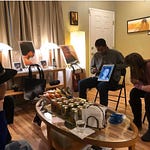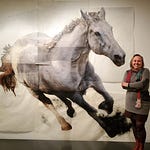What does it mean to get lost in the trauma of life? Or, to get sidelined by the blows and body slams of crippling circumstances? Playwright and actress Amontaine Aurore’s, When A Tree Falls, traverses the rough terrain of a rural family’s life when everything that could go wrong does, and when life’s losses pile one atop another creating such a cascading effect that escaping into delusions is a viable alternative to facing harsh realities. I first saw When A Tree Falls before the pandemic shutdowns of live performance (including theatre). An early draft of the show premiered at 18th and Union. It was thought-provoking and emotionally gripping. The official premiere, on November 13th at a small film house in Upper Queen Anne, hadn’t lost any of its power. It was a slow burn, with an emotional intensity that still sits with me days later. It was filmed by Trial and Error Productions, and projected on a screen. It had some cinematic elements (close ups and photographic filters) but the basic theatre format remained the same — the actors performed on a set crafted to fit the melancholy mood of the script and the storyline moved forward through dialogue that carefully unveiled surprising and tragic truths. And it was all set against the backdrop of a struggling logging town in Washington State, in 1991, where the unspoken tensions between a white woman and her adopted mixed-race daughter simmered just beneath the surface. As I spoke with Amontaine Aurore in an interview about her artistic journey, I could see some autobiographical aspects of the story but I also could see where she had reached beyond her own experience to write the other.
“I write very diverse characters,” said Aurore during a telephone interview with Artists Up Close. “So again, there's some of my family in there, but there's also a lot of people that I've known, but also people that I haven't known but I'm interested in. So, when I started to write these characters, in order to not write black and white characters or one-dimensional characters, I have to investigate them deeper. And I have to figure out why they are the way they are. If you're writing a villain, there's a reason that that person is the way that they are. And if I just write, someone that just does bad things, and we don't understand why they might be doing these bad things, I think that's boring. So, I've had to investigate people who may be the opposite of me, to see why they are the way that they are. And to bring that out to the forefront.”
Aurore hasn’t always considered herself a writer. She spent many years trying to make it as an actress in Los Angeles, in the 1980s and early 90s, before becoming frustrated with the scene and returning to Seattle.
“I've always loved plays and poetry and literature,” Aurore said. “I've always loved investigation. And so, as an actor, there were many roles that I loved playing, but I also felt like they were limited. And I wasn't necessarily, you know, getting the roles or playing the roles that were the really meaty or juicy or multi-layered characters that I wanted to play.”

Back in the 1980s and 90s, Black actresses were a rare sight in film, and when they were visible it was usually in slave dramas (e.g., The Color Purple), school dramas (e.g., Lean On Me and Dangerous Minds), and stories about gangs (e.g., New Jack City and Boys In The Hood). And it wasn’t just the limited themes of these films but also the character development which often relied on sexed-up stereotypes about Black womanhood or leaned heavily into the narrative of the dysfunctional and traumatized Black mother (e.g., Losing Isiah). This limiting palette of roles compelled Aurore to consider creating (as a writer) the types of roles she longed to play. So, soon after returning to Seattle she enrolled in Antioch University. The experience transformed the way she viewed herself.
Listen to this episode with a 7-day free trial
Subscribe to Artists Up Close to listen to this post and get 7 days of free access to the full post archives.














